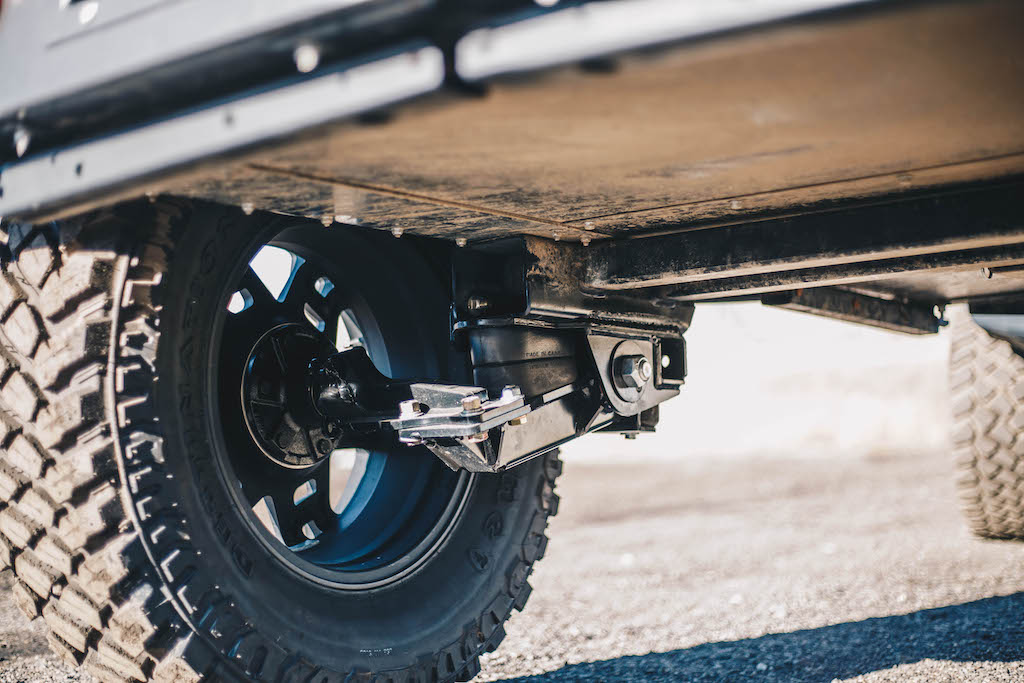The Problem
Towing a trailer in the bush has always been a problem because of the limitations associated with the suspension. Even if you own a great off-road vehicle, it’s the trailer that presents a challenge. The main problem, of course, is the through-axle. It remains the most vulnerable to any rocks and tree stumps along the trail.
If the axle could somehow be eliminated… wouldn’t that solve the issue?
Our story began about 10 years ago. The US military had a problem. Trailers that were used to pick up the injured on the battlefield had – you guessed it – limited use, i.e. they weren’t able to safely go where the tow vehicle could. The medics needed a trailer that could go anywhere, even on rough terrain.
The Solution
Who was it that said, “Necessity is the mother of invention?” Our story certainly illustrates the truth of this statement…
A company in Oregon contacted Timbren back in 2010 wanting to know if we could provide a solution for the military. After several months of phone calls and emails, we offered them an original idea for their prototype.
Our friends in Oregon liked the proposal, but they failed to win the contract. So, at the end of the day, Timbren had a really cool idea for a trailer suspension. And so began the task of refining a good idea to make it great.
But what do you call such an invention?
The Concept
This design is an original idea, the first of its kind. As you have probably guessed, the concept is simple. It involves eliminating the through-axle. That’s why we named it “Axle-Less.”
No axle. None. Nada. Nichts.

The obvious benefit from having no axle is, of course, extra ground clearance. When you’re driving through rough terrain, the last thing you need is a bent or broken axle slowing you down.
Another Axle-Less advantage is both wheels can move independently of each other. For that reason, the Axle-Less design provides a quiet, smooth ride at all times.
Let’s take a closer look at the components found in the Axle-Less suspension, what they’re made of, and how they contribute to the design of a better off-road trailer suspension.
Components
- Steel hanger

Since there is no axle, where do the wheels go?
On the frame, of course!
The hanger facilitates a simple, bolt-on installation. Each hanger comes with 3 laser-cut holes. These holes can be used as a template to mark the frame where the holes need to be drilled.
The hanger also has a 2” square hole through which a steel pipe can be fed for frame reinforcement. The steel pipe can be bolted or welded in place.
- Control arm

Control arms are a critical component of an independent suspension system, controlling the motion of the wheels. Simply put, they allow the tires to smoothly move up and down. Without them, the ride would be rough. The control arm on the Axle-less suspension holds the jounce spring, the rebound spring and the outboard arm in place.

Premium urethane bushings help to fasten the control arm to the hanger. Small grooves have been machined into the bushings allowing grease to lubricate the pivot point. The urethane bushing provides added quietness to the suspension. As a result, you won’t have to listen to any annoying squeaks and rattles when towing your trailer.
- Jounce spring

Aeon® rubber springs have been the heart of the Timbren solution since day one. That’s because rubber springs have certain characteristics that you don’t get with metal and air: Progressive spring rate and shock-absorption.
The jounce spring used in the Axle-Less suspension is Timbren’s latest development in rubber spring technology. Its unique wedge-shape design works perfectly with the up and down motion of the control arm. Made entirely of natural rubber, the jounce spring delivers a perfect combination of strength, stability and smoothness.
- Rebound spring

The rebound spring is a single-convoluted Aeon® hollow rubber spring that plays an important role. This small, somewhat hidden spring puts constant tension on the much larger jounce. The result? Full or empty, the trailer always maintains a smooth ride, and will never bounce around like a typical leaf-spring trailer suspension.
The unique characteristics of a hollow rubber spring apply to the rebound: Progressive spring rate and shock absorption. Both jounce and rebound springs contribute to a quiet, controlled ride even on rough terrain.
- Outboard arm

The last piece of the suspension puzzle is the spindle. It’s welded to a metal arm, and together they make up the outboard arm. Before the suspension can be bolted to the trailer frame, the outboard arm must first be bolted to the control arm.
The outboard arm comes with built-in camber. Metal shims are also included to make any necessary adjustments as you bolt the arm in place.
If the spindle gets damaged, replacing it is a snap. Just undo the four bolts, remove the damaged arm, and bolt the new component back on to the control arm. The EZ-lube spindles are also easy to maintain.
Conclusion
Since its award-winning debut, the Axle-Less trailer suspension has captured the attention of the off-road community. And why not? This clever design is pure genius! Interest has grown so much lately that Timbren plans to expand their operation in order to better meet the growing demand.
It’s a simple concept: No through axle.
Is that a problem? Not at all… It’s the solution!
The Axle-Less is basically five components that work together to produce what many agree to be a better off-road trailer suspension. It’s better because it allows for:
- Maximum ground clearance
- A smooth, quiet ride
- Greater control even on the roughest terrain.
For more information on how to install the Axle-Less, click on the link below
